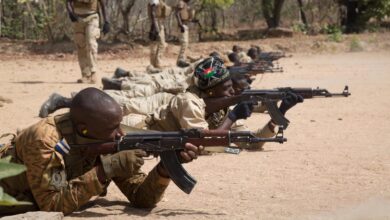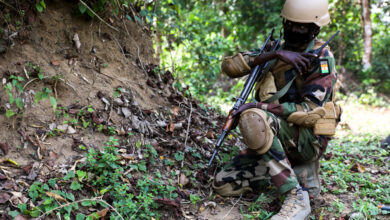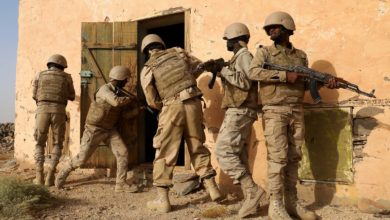The United States has almost doubled its assistance to the G5 Sahel Joint Force member states to almost $111 million, the U.S. military’s Africa Command said.
Launched in 2014 to improve cooperation on development and security between Burkina Faso, Chad, Mali, Mauritania and Niger, the G5 Sahel began work in 2015 on the G5 Sahel Joint Force, a counter-terrorism initiative which was spearheaded by France, the colonial power in the region.
A June 2017 United Nations Security Council resolution called for international support, and the force launched a month later with a mandate to combat terrorism, transnational organized crime and human trafficking in the Sahel area.
“We’re able to confirm that since our initial pledge of $60 million in October 2017, U.S. assistance has nearly doubled to approximately $111 million to meet the needs and strengthen the capabilities of the G5 Sahel Joint Force,” Africom public affairs officer Nate Herring told The Defense Post.
“We stand by and are committed to this important African-led initiative as they work to bring peace and security to the Sahel,” he added.
A U.S. State Department official told The Defense Post the funding was obligated in Fiscal Year 2018.
“The $111 million in direct security assistance to the Joint Force includes State Foreign Assistance and DOD program funds,” the official said.
“An additional $131 million in non-Joint Force security assistance was obligated to the G5 countries,” the official added, explaining that that assistance is “focused on strengthening the military, justice, and law enforcement capabilities of our G5 partners.”
Originally projected to be fully up and running last March, the force has struggled to make a significant impact, mainly due funding and organizational issues. Its first mission, November 2017’s Operation Hawbi, was beset by “logistical problems” although officials insisted at the time they were not insurmountable.
France’s Minster for the Armed Forces Florence Parly said on October 8 that five operations had been conducted since, and the force was to launch three operations in “coming weeks.”
Her comments followed earlier remarks made by the new G5 Sahel joint force commander, Mauritanian General Hanena Ould Sidi, who said on October 2 the force was planning operations that “will take place shortly” with a view to “neutralize terrorists.”
He replaced the force’s first commanding officer, Malian General Didier Dacko, after a suicide bomb and gun attack destroyed its headquarters in Sevare. The June 29 assault was reportedly claimed by an official from the Support Group for Islam and Muslims (JNIM), which is linked to al-Qaeda.
The European Union said in July that it would finance the construction of a new headquarters in Mali, and Hanena Ould Sidi said in September that G5 Sahel Joint Force headquarters will move to Mali’s capital Bamako.
Thirty-five senior officers were inducted into the G5 Sahel Defence Academy in the Mauritanian capital Nouakchott on October 15. The eight-month program aims to train future leaders of the joint force.
It is unclear when the decision to increase U.S. support was taken, but it was flagged by Parly, who said during a joint press conference in Paris with U.S. Defense Secretary James Mattis on October 2 that the U.S. would “very significantly” increase its contribution.
The contribution may in part signal that the U.S. focus on counter-terrorism is shifting further afield as Islamic State loses the last pockets of its territory. This year’s installment of the Pentagon’s annual Countering Violent Extremism Conference on October 16 included 83 defense chiefs, as well as Brett McGurk, the U.S. Special Presidential Envoy for the Global Coalition to Defeat ISIS, who has until now largely focused on Iraq and Syria.
The Chairman of the U.S. Joint Chiefs of Staff, General Joseph Dunford told journalists that the conference spent some time discussing West Africa and the G5 Sahel, and that the the commander from the G5 Sahel mission give a presentation.

US assistance to allow each G5 member to maintain a battalion-sized force
“The U.S continues to support the G5 member states through a number of bilateral security cooperation efforts,” Herring said. “Our assistance provides equipment, training, and advisory support to allow each G5 member to operate and maintain a battalion-sized force in their fight against violent extremist groups in the region.”
The State Department official said the U.S. support will “allow G5 members to operate, protect, and maintain mobile infantry forces,” adding that it enables G5 nations “to more effectively engage” and reduces threats to U.S. national security and the security of U.S. partners in the region.
Africom has two operational planners in place at a G5 Sahel Joint Force headquarters to support efforts to counter violent extremist organizations.
The plan for the Joint Force will see it expand to around 5,000 troops divided into seven battalions – two from both Mali and Niger, and one each from Chad, Burkina Faso and Mauritania.
It has three zones of operation: the Mali-Mauritania border; the border region between Burkina Faso, Mali and Niger; and the Niger-Chad border.
Troops will work alongside the roughly 4,500 French personnel deployed to Operation Barkhane which has a mandate for counter-terrorism operations across the region, as well as the U.N. Minusma stabilization mission in Mali, which has about 12,000 troops and 1,750 police deployed.
“This effort complements E.U. and French logistical support and is just a small part of larger U.S. efforts to develop security institutions and combat capabilities of our G5 partners,” Herring added.
In May, the E.U. extended the mandate of its own training mission in Mali until May 2020, and amended the mission’s mandate to include the provision of advice and training support to the G5 Sahel Joint Force. It also increased EUTM Mali’s budget to €59.7 million for the two-year period.

Islamic extremists linked to al-Qaeda took control of the desert north of Mali in early 2012, exploiting a Taureg separatist uprising.
France began its Operation Serval military intervention the next year, which largely drove out the jihadists. That mission evolved into the current Operation Barkhane deployment.
But the insurgency has since grown and gradually spread to the country’s center. The militant groups have morphed into more nimble formations operating in rural areas, sometimes winning over local populations by providing basic services and protection from bandits.
The government and armed groups signed a peace deal in 2015, but implementation has been slow, and large stretches of the country remain outside government control.
Violence has spread to Niger and notably Burkina Faso, which has called on French air support twice in recent weeks to help deal with militant attacks, the first time it has done so.
On October 22, the U.S. State Department’s Trans-Saharan Counter-Terrorism Program provided Burkina Faso with $1.5 million worth of equipment. The American Embassy in Ouagadougou said it was “part of a G5 Sahel equipment donation of $30-40 million, planned for 2019.”
The State Department official confirmed “approximately $40 million” in Joint Force security assistance to Burkina Faso.
According to an October study by the U.S. Defense Department’s Africa Center for Strategic Studies, violent incidents linked to militant Islamist groups in the Sahel tripled over the previous 12 months. ACSS recorded 377 episodes and 895 fatalities.
ACSS said the JNIM coalition was primarily responsible, but it said Abu Walid al Sahrawi’s Islamic State in the Greater Sahara (ISGS) was linked to roughly a quarter of all “violent events” attributed to militant Islamists in the region. It said that there are suggestions of “growing collaboration” between ISGS, JNIM and Ansaroul Islam, Ansar Dine’s branch in Burkina Faso.

Calls for regular, predictable funding for G5 Sahel
But Parly has regularly reiterated in Chad that the force is still inadequately equipped.
The force has received €100 million in financial support from the E.U., but much of around €420 million ($478 million) that was pledged at an international donor conference in Brussels on February 23 has not been fulfilled.
“At the moment, [pledges] are materializing very slowly,” Parly told reporters on Sunday, November 4, adding that only “10 to 25 percent of the funds” have been disbursed.
Saudi Arabia made the biggest single pledge – €100 million-worth of equipment – but it has yet to be delivered, Parly said while traveling to Senegal for the Dakar International Forum on Peace and Security.
“The goal [of the Dakar Forum] is firstly to maintain the priorities on [G5 Sahel] operations,” Parly said, again adding that the joint force “is not equipped as it should be.”
“The rainy season is coming to an end, so it’s important to get operations going again. Some have already been planned.”
Speaking at the U.N. General Assembly on September 26, Mali’s President Ibrahim Boubacar Keita said the G5 Sahel Joint Force was “struggling to become fully operational,” highlighting the lack of an adequate mandate and “especially appropriate funding.”
Keita again urged the Security Council to provide it with “adequate, timely and predictable funding.”
U.N. Secretary General Antonio Guterres has pledged to pursue support for the force. Guterres, as well as France, has lobbied for regular U.N. funding, in addition to support already agreed by the Security Council in December, when it authorized Minusma to provide assistance to the joint force in Mali. That support can include medical and casualty evacuations, the provision of fuel, water and food, as well as assistance in the preparation of bases.
But on May 23, the U.S. said it opposed a Security Council mandate for the force as well as direct U.N. funding.

US military presence in the Sahel
Herring said there were fewer than 1,000 Department of Defense personnel deployed to G5 Sahel states. Those personnel, which include military, civilians and contractors, support “a range of security force assistance and capacity building efforts between the G5 Sahel nations,” he said.
Not all of these personnel “work on the problem set specifically related to the G5 Sahel,” Herring said, citing the example of personnel in Niger and Chad who support efforts related to the Multinational Joint Task Force (headquartered in N’Djamena, Chad), working to counter Boko Haram and Islamic State West Africa Province in the Lake Chad region.
According to reports, there are about 800 U.S. personnel in Niger, where the U.S. is also building a large air base near Agadez. The $110 million Air Base 201 project, due to be operational next year, will house drones and fighter jets, and will be capable of launching strike and surveillance missions in West and North Africa.
Boko Haram has lately intensified its armed campaign. Attacks on military bases in Nigeria have been on the increase, with at least nine since July, mostly in the northern part of Borno state near the shores of Lake Chad. Scores of soldiers have been killed, injured or are missing, but the military has repeatedly denied or played down losses.
The Pentagon’s ACSS said that Boko Haram-linked violence over the past 12 months “has remained consistent with levels observed over recent years.” It estimated 534 violent events resulted in 3,048 fatalities.
Boko Haram is divided into two factions that have competing goals and operational methods. One, led by Abubakar Shekau, is notorious for suicide bombings and indiscriminate killings of civilians. The other, known as Islamic State West Africa Province and led by Abu Mus’ab Al-Barnawi, largely focuses on attacking military and government targets.
ISWAP has in recent months been blamed for the increasing attacks on military bases. It is dominant around Lake Chad, while the Shekau-led faction is concentrated in rural areas of Borno state.
The Combatting Terrorism Center at West Point in August estimated that ISWAP has around 3,500 fighters. The Shekau faction could consist of up to 1,500 militants.
More radical elements are said to have recently taken over the ISWAP leadership, killing the group’s de fatco leader, as well as another commander who allegedly planned to surrender along with 300 hostages. ISWAP previously vowed to hit only military and government “hard” targets.












